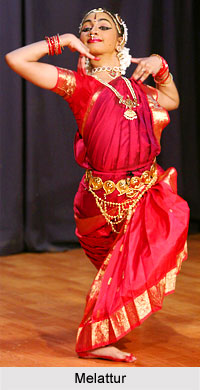 Melattur style of Bharatnatyam dance was innovated, developed and improvised greatly out of devadasi traditions and Melattur Bhagavata Mela by Mangudi Dorairaja Iyer, a sanyasi following Srividya Upasana. Mangudi Dorairaja Iyer was born in the year 1900 and died in 1980.
Melattur style of Bharatnatyam dance was innovated, developed and improvised greatly out of devadasi traditions and Melattur Bhagavata Mela by Mangudi Dorairaja Iyer, a sanyasi following Srividya Upasana. Mangudi Dorairaja Iyer was born in the year 1900 and died in 1980.
Bharatnatyam Dancer of Melattur Style
Mangudi Dorairaja Iyer re-established the Suddha Nrittam (complicated and stylized tapping footwork that searches various time measures in various tempos), Bhattasa Natyam and Perani Natyam (dance on the clay pot). He became associated in Shuddha Nrittam after watching a brilliant performance by devadasi of Cheyyur Sengalvarayar temple, who performed it along with other 71 types of items (e.g. Kavita, Nritta, Vadya, Sangeeta and others).
Themes
Mangudi went against the traditional Bharatnatyam gurus and avoided all the items that glorified the poets human patrons, as performing such items would not go with his devotion to spiritual practices of Srividya Upasana. It is only the holy rishis or the deities who are considered of such glorification. Thus, the elements or repertoire of a Melattur style dancer consists mostly of the ancient items performed in the temples.
Footwork
In the Melattur style of dancing, instead of stumping the foot hard against the floor the dancer is expected to use salangai (ankle bells) in a better manner that helps in producing rich variety of sounds and also glorifies the rhythm.
Another typical feature is the presence of pancha nadais and wide use of gati bhedas. For instance in varnam there would be gati bhedam in every jati. There is a particular stress on crisp adavus, fluid variations or patterned korvais.
Abhinaya
Due to the influence of Melattur Bhagavata Mela, this style uses the dramatic style, i.e characterisation which requires highly complicated and expressive abhinaya. The facial expression needed for Melattur style dancer are not so rigidly defined like in case of other styles of Bharatnatyam. And it is not understated or theatrical, but required high degree of individual improvisation and introspection. As a result of devadasi association, there is tremendous emphasis on sringara rasa, rather than on neutral bhakti.
The nritta abhinaya is varied from most other styles in the sense that each body movement is to be reflected in a different facial expression in a spontaneous manner.
Other Distinctive Features
* The dance movements are supposed to be performed with larger amplitude on a wide scale of tempos, making it physically the most demanding style of Bharatnatyam.
* The application of loka dharmi and natya dharmi is different from other Bharatnatyam styles.
* The Melattur style dancers wear a special protective cotton belt around their waist




